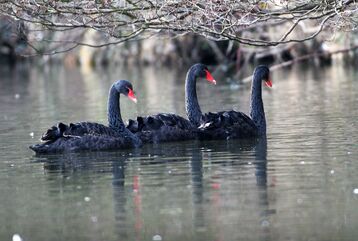The Black Swan (Cygnus atratus) is a large waterbird which breeds mainly in the southeast and southwest regions of Australia.

Black Swans - http://www.flickr.com/photos/48035701@N04/
Description[]
Black Swans are primarily black feathered birds, with white flight feathers. The bill is bright red, with a pale bar and tip; and legs and feet are greyish-black. Cobs (males) are slightly larger than pens (females), with a longer and straighter bill. Cygnets (immature birds) are a greyish-brown with pale-edged feathers.
A mature Black Swan measures between 110 and 142 cm (43-56 in) in length and weighs 3.7–9 kg (8.1-20 lbs). Its wing span is between 1.6 and 2 metres (5.3-6.5 ft). The neck is long (relatively the longest neck among the swans) and curved in an "S".
The Black Swan utters a musical and far reaching bugle-like sound, called either on the water or in flight, as well as a range of softer crooning notes. It can also whistle, especially when disturbed while breeding and nesting.
Distibution[]
The Black Swan is also very popular as an ornamental waterbird in Western Europe, especially Britain, and escapes are commonly reported. As yet the population in Britain is not considered to be self-sustaining and so the species is not afforded admission to the official British List, but the Wildfowl and Wetlands Trust have recorded a maximum of nine breeding pairs in the UK in 2001, with an estimate of 43 feral birds in 2003/04 (though that is undoubtedly an under-estimate given the level of monitoring undertaken).
A colony of Black Swans in Dawlish, Devon has become so well associated with the town that the bird has been the town's emblem for forty years.

Black Swans - http://www.flickr.com/photos/48035701@N04/
Behaviour[]
Bearing[]
When swimming, black swans hold their necks arched or erect, and often carry their feathers or wings raised in an aggressive display. In flight, a wedge of black swans will form as a line or a V, with the individual birds flying strongly with undulating long necks, making whistling sounds with their wings and baying, bugling or trumpeting calls.
Nesting and sexuality[]
Generally, black swans nest in the wetter winter months (February to September), occasionally in large colonies. A typical clutch contains 4 to 8 greenish-white eggs that are incubated for about 35–40 days. After hatching, the cygnets are tended by the parents for about 6 months until fledging, and may ride on their parent's back for longer trips into deeper water.
A Black Swan nest is essentially a large heap or mound of reeds, grasses and weeds between 1 and 1.5 metres (3-4½ feet) in diameter and up to 1 metre high, in shallow water or on islands. A nest is reused every year, restored or rebuilt as needed. Both parents share the care of the nest. Like other swans, the black swan is largely monogamous, pairing for life (about 6% divorce rate). Recent studies have shown that around a third of all broods exhibit extra-pair paternity. An estimated one-quarter of all pairings are homosexual, mostly between males. They steal nests, or form temporary threesomes with females to obtain eggs, driving away the female after she lays the eggs.
